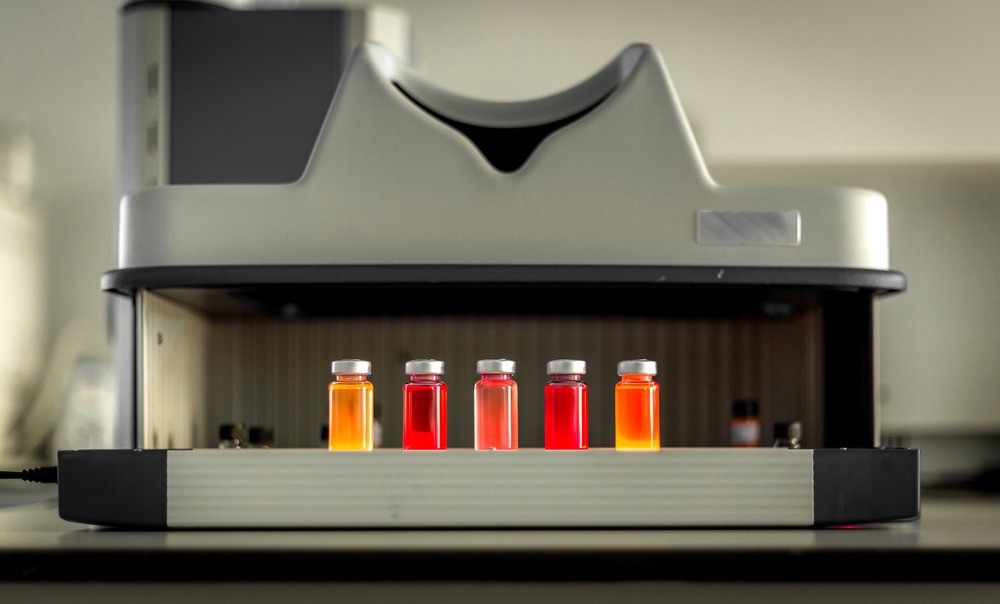Quantum dots (QDs) are semiconductor nanocrystals, typically ranging from 1 to 10 nanometers in size, that exhibit quantum mechanical behaviors that make them highly desirable for a wide range of applications. Here, we discuss the details of quantum dot synthesis, highlighting the challenges, breakthroughs, and the evolving landscape of mass production.

Image Credit: Tayfun Ruzgar/Shutterstock.com
Quantum Dot Synthesis Methods
Quantum dots are composed of semiconducting materials like cadmium selenide (CdSe) or indium arsenide (InAs) and can be synthesized through various methods. For instance, colloidal synthesis and hydrothermal synthesis are two of the commonly used methods for quantum dot synthesis.
Colloidal Synthesis via Hot Injection Method
Colloidal synthesis via hot injection is a prominent method for quantum dot production in which metal ions or organometallic compounds are dissolved in a solvent and swiftly injected into a high-temperature reaction mixture, allowing for the rapid formation of QDs that cool and solidify.
This approach offers precise control over QD size and composition by adjusting precursor type, concentration, reaction time, and temperature. Colloidal synthesis exhibits advantages like size and shape control, high purity, and low defect density, making it scalable for diverse QD applications.
Hydrothermal Synthesis
Hydrothermal synthesis is a cost-effective method for quantum dot synthesis. It involves placing a precursor solution containing metal ions and ligands in a sealed container, heating it under high pressure in a water bath, and inducing supersaturation and subsequent QD nucleation.
This method stands out for its ability to produce high-quality QDs at relatively low temperatures compared to alternative techniques. Hydrothermal synthesis extends to carbon QDs (CQDs) doped with nitrogen, termed NCQDs, presenting enhanced imaging capabilities for bioimaging.
From Laboratory-Scale to Industrial Scale Synthesis
In the early stages of quantum dot research, laboratory-scale synthesis was primarily focused on understanding the fundamental principles of nanocrystal formation. Researchers explored different chemical precursors, solvents, and reaction conditions to optimize the synthesis process, allowing for fine-tuning quantum dot properties and identifying key parameters affecting their size and stability. However, using toxic elements in quantum dot synthesis, such as cadmium, raised environmental and safety concerns.
Additionally, achieving reproducibility on a larger scale proved to be challenging due to the sensitivity of quantum dots to variations in reaction conditions. Hence, in transitioning from laboratory-scale synthesis to mass production, advancements in technology and the involvement of industry players played pivotal roles.
The shift from laboratory-scale synthesis to mass production required substantial investment and collaboration. Industrial partners recognized the potential of quantum dots in various applications, from high-efficiency displays to solar cells, which led to increased funding and partnerships between academic institutions and corporations, aiming to bridge the gap between scientific discovery and commercial viability.
Recent Developments
Automated Quantum Dot Synthesis
In a recent study, researchers introduced an Artificial Chemist, combining machine learning-based experiment selection with high-efficiency autonomous flow chemistry to synthesize inorganic perovskite quantum dots. This self-driving system autonomously produced tailor-made QDs, adjusting quantum yield and composition polydispersity across target bandgaps from 1.9 to 2.9 eV.
Remarkably, the Artificial Chemist generated eleven precision-tailored QD compositions within 30 hours, utilizing less than 210 mL of starting QD solutions without user experiment selection. Furthermore, the system demonstrated the ability to pre-train on prior experiments, accelerating synthetic path discovery by at least twofold.
This innovative approach not only streamlines the synthesis of QDs but also addresses challenges related to precursor variability, resulting in QDs consistently within one meV of their target emission energy.
Large Scale Quantum Dot Synthesis
In a 2015 study on quantum dot industrial synthesis, researchers focused on scaling up production for advanced energy applications. The commonly used hot injection method, suitable for small-scale R&D, faces challenges in large-scale synthesis. The study delves into non-injection organic synthesis methods, addressing the need for fast and homogeneous reactions in large volumes.
Researchers developed approaches using two precursors simultaneously, emphasizing the importance of precursor reactivity transitions near the desired growth temperature. Successful synthesis was demonstrated in binary and ternary systems like CdSe, CdS, and PbS. The non-injection approach offers potential for large-scale production, crucial for the commercialization of optoelectronic devices, particularly in the fields of solar cells and solid-state lighting.
The study emphasizes the significance of easy processing, high reproducibility, low cost, and environmental friendliness in achieving practical industry applications.
Conclusion
In conclusion, the journey from laboratory-scale synthesis to mass production of quantum dots has been marked by significant strides, overcoming challenges through innovation and collaboration. The transition to industrial-scale synthesis necessitated substantial investment and a shift away from toxic elements.
Developments like the Artificial Chemist and non-injection organic synthesis methods showcase groundbreaking advancements in automating and scaling up quantum dot production. These innovations not only streamline synthesis processes but also address challenges, propelling quantum dots closer to practical industry applications in fields like energy and optoelectronics.#
References and Further Reading
Agarwal, K., et al. (2023). Quantum dots: an overview of synthesis, properties, and applications. Materials Research Express. doi.org//10.1088/2053-1591/acda17
Epps, R. W., et al. (2020). Artificial chemist: an autonomous quantum dot synthesis bot. Advanced Materials. doi.org/10.1002/adma.202001626
Hu, M. Z., & Zhu, T. (2015). Semiconductor nanocrystal quantum dot synthesis approaches towards large-scale industrial production for energy applications. Nanoscale research letters. doi.org/10.1186/s11671-015-1166-y
Li, Y., et al. (2019). Stoichiometry-controlled InP-based quantum dots: synthesis, photoluminescence, and electroluminescence. Journal of the American Chemical Society. doi.org/10.1021/jacs.8b12908
Magesh, V., et al. (2022). Recent advances on synthesis and potential applications of carbon quantum dots. Frontiers in Materials. doi.org/10.3389/fmats.2022.906838
Navarro-Badilla, A., et al. (2023). Green Synthesis for Carbon Quantum Dots via Opuntia ficus-indica and Agave maximiliana: Surface-Enhanced Raman Scattering Sensing Applications. ACS omega. doi.org/10.1021/acsomega.3c02735
Disclaimer: The views expressed here are those of the author expressed in their private capacity and do not necessarily represent the views of AZoM.com Limited T/A AZoNetwork the owner and operator of this website. This disclaimer forms part of the Terms and conditions of use of this website.